RestaurantHub.be – From Mollie Integration to Full-Fledged Platform
RestaurantHub.be is a Belgium-based food ordering platform that began with a simple request: integrate the Mollie payment gateway. The client discovered us through our YouTube tutorial on Mollie integration in Laravel and reached out via our blog.
Discovery Phase
Identifying the Problem
The initial problem was the lack of a secure and reliable payment gateway on the platform. But soon, the scope expanded into revamping the entire system for performance, SEO, and scalability.
Competitor Analysis
We assessed popular platforms like Uber Eats and Deliveroo to understand how RestaurantHub could offer a more localized and affordable solution for Belgian restaurants.
Setting Goals
- Seamless Mollie integration
- Increase website traffic
- Transform platform to support multi-restaurant vendors
- Launch mobile apps to capture the growing mobile user base
Planning and Strategy
Feature Prioritization
We prioritized:
- Vendor onboarding
- Order management
- SEO-friendly product/menu pages
- Mobile API setup
Technology Stack
- Backend: Laravel (latest version)
- Frontend: HTML5, Bootstrap 5
- Database: MySQL
- Hosting: AWS EC2
- Mobile Apps: Flutter (native Android & iOS)
Timeline
The project was executed in multiple sprints over several months in 2023.
Design Process
UI/UX Considerations
The original design was inconsistent and not optimized for modern UX. We redesigned key flows like restaurant dashboards, cart views, and order tracking pages.
Tools Used
Figma was used to create and validate design flows for both the website and mobile apps.
Feedback Loops
Designs were shared with the client and actual restaurant owners to collect feedback for iteration.
Development Process
Frontend Development
All frontend work was completed using HTML and Bootstrap, ensuring fast page loads, responsive design, and mobile-first optimization.
Backend Development
We restructured the backend using:
- Custom cart and language modules (to replace outdated packages)
- Role-based multi-vendor support
- Optimized Eloquent queries
- Background job queues for order handling
APIs and Integrations
- Mollie payment API
- Custom REST APIs for mobile apps
- Planned delivery API for future logistics automation
Agile Sprint Cycles
We used Trello for sprint management and GitHub for version control with a strict branching and merge policy.
Challenges and Solutions
Legacy Database Structure
The client had already set up part of the database, but it lacked optimization.
Solution: We refactored the structure, indexed foreign keys, and cleaned up redundant relationships to improve load speed.
Deprecated Packages
Third-party packages (cart, language) used were outdated and incompatible.
Solution: Custom Laravel-compatible modules were created.
Simultaneous Order Processing
To handle multiple real-time orders across restaurants, we used Laravel queues and jobs to maintain speed and prevent conflicts.
Testing and QA
Git Workflow
- No use of dd() or console.log() allowed in final PRs
- All commits required descriptive messages
- Code reviewed and tested before merges
Manual & Automated Testing
- UAT with real restaurant data
- PHPUnit for backend logic
- Device-based testing for mobile apps
Deployment and Launch
Infrastructure
- Hosted on AWS EC2
- Git-based deployment for syncing new features
- Cron jobs for cache clearing, order alerts, and queue workers
- Error monitoring with email notifications sent to admin
Launch
- Gradual vendor onboarding
- SEO-optimized landing pages
- Google My Business integration for location-based discovery
Post-Launch Insights
- 70% traffic increase in just 2 months after SEO updates
- Mobile app adoption gained traction, especially on Android
- Multiple restaurants onboarded within weeks
- Vendors appreciated the easy-to-use dashboard and localized platform features
Key Takeaways
Lessons Learned
- Early technical debt should not be ignored—refactoring was worth the time
- SEO drives real, measurable results for food ordering platforms
- Mobile-first strategy ensures wider adoption
Advice for Future Projects
- Always invest in proper database architecture early
- Plan for scalability, even in MVP phase
- Don’t ignore performance optimization—it impacts user retention
What We’d Do Differently
- Audit existing systems more thoroughly before building
- Integrate monitoring tools earlier
- Start restaurant feedback loops during the design phase
Conclusion
What started as a one-time Mollie integration turned into a long-term collaboration that transformed RestaurantHub.be into a scalable, multi-restaurant platform complete with native mobile apps.
From performance to SEO and user experience, we helped RestaurantHub position itself as a local, reliable alternative in Belgium's food tech space—and with continued growth, the future looks even more promising.









